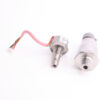Pressure spikes created by quickly closing valves, positive displacement pumps and vertical pipe runs can have damaging effects. These include blown diaphragms, broken seals and damage to gaskets, meters and gauges.
For all practical purposes liquid is not compressible, and so any energy applied to it is instantly transmitted. When a force such as a quickly closing valve or a pump applies velocity to the fluid this energy becomes dynamic.
Surge (water hammer)
A sudden change in liquid velocity, such as that caused by suddenly starting or stopping a transfer system, or if the liquid makes a rapid change in direction, is commonly known as a “surge” or “water hammer”. The primary cause of water hammer in process applications is a quickly closing valve, whether manual or automatic. A valve, depending on size and system conditions, closing in 1.5s or less, will cause an abrupt stoppage of flow. The pressure spike (acoustic wave) created by rapid valve closure can be as high as five times the working system pressure.
This pressure spike or wave will rapidly accelerate unrestricted to the speed of sound in liquid, which can exceed 4000ft/s.
It is possible to estimate the pressure increase, and there are many water hammer calculators available on the market, However, we have found that these calculators can provide a wide range of results. The most effective way is still the old fashioned pen and paper using the following formula:
P = (0.070VL/t) + P1
where P = increase in pressure (psi)
P1 = inlet pressure (psi)
V = flow velocity (ft/s)
t = valve closing time in (s)
L = upstream pipe length (ft)
For example, when closing a solenoid valve with a 50ft long upstream pipe connection:
L = 50ft
V = 5.0ft/s (recommended velocity for PVC piping design)
t = 40ms (solenoid valve closing time is typically 40-50ms)
P1 = 50psi inlet pressure
Therefore P = 0.07 x 5 x 50/0.040 + P1
or P = 437.5psi + P1
total pressure = 437.5 + 50 = 487.5psi
Pulsation
Pulsation generally occurs when a liquid’s motive force is generated by a reciprocating or peristaltic positive displacement pump, and is most commonly caused by the acceleration and decelerations of the pumped fluid. This uncontrolled energy appears as pressure spikes and usually leads to damaged seals, gauges, diaphragms, valves and piping joints.
The visual manifestation of pulsation is vibration.
The instantaneous pressure required to accelerate the liquid in a pipeline can be greater than ten times the steady flow pressure produced by a centrifugal pump. Centrifugal pumps normally produce non-damaging high-frequency but low-amplitude pulses, which are the pressure spikes.
Solution
The solution is to install a pulsation dampener or surge suppressor. These devices are essentially the same: the difference primarily, lies in sizing and pressurisation. They are the most effective choice and a cost efficient way to prevent damage caused by pulsation.
A hydropneumatic dampener is the most modern form of pulsation dampener. It comprises a pressure vessel containing a compressed gas (generally air or nitrogen), separated from the process liquid by a bladder or diaphragm. The dampener should be installed as close as possible to the pump or quick closing valve and is charged to 85% of the liquid line pressure.
It is important to specify the correct pulsation or surge suppressor, and this requires careful calculation. It is always worth consulting the manufacturer who will ensure you have the correct sizing for a particular application.
Conclusion
By knowing and eliminating problems beforehand, you can avoid situations that will create water hammer and pulsation during a specific process, avoiding failed valves, equipment and costly downtime.
Read more: Index to all of our Technical Notes on Pressure
Have a pressure application you want to discuss? Let us call you…
Why Us?
- Suppliers of top quality strain gauge sensors and transducers to every corner of industry – UK and worldwide
- Over 100 years of expert transducer knowledge
- Our high quality products all come with a 3 year warranty





